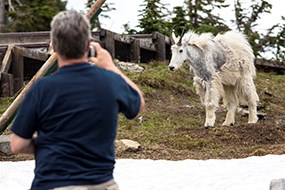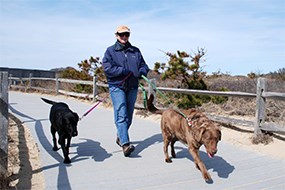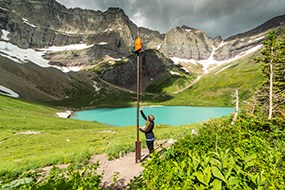Is It Beneficial Or Harmful For Wild Animals To Have Interactions With People?
Risks to Wildlife from People
Smart Wild fauna Watching Protects Wildlife
Watching wild animals safely is the responsibleness of all park visitors. When you lot visit national parks, you are entering animals' habitat and should behave like a polite guest. In fact, the safe and health of wildlife depends on the thoughtful choices park visitors brand.
Wildlife confront some serious risks when humans go close plenty to interact with them:

NPS Photo / Jim Peaco
Consequences of Physical Contact with People
Although many wild fauna appear tame, they are non. It's all-time to resist the urge to pet and concur them. In fact, some animals, from bison to birds, may exist rejected past their parents if they have contact with humans, making them more vulnerable to predators or other harmful situations. In addition, wild animals can become injured when they attempt to escape people who take gotten too close, peculiarly if they are near human structures or roads. Wildlife that get used to being effectually people and developed areas such as picnic areas and campgrounds besides are at greater take chances of eating human food and communicable diseases from people and pets or giving diseases to humans and their pets.

NPS Photo
Fatal Diseases from People and Pets
Our domestic pets can also pose real dangers to the wild fauna inside parks. Both pets and people may have diseases that they can give to wildlife. Sadly, there are many examples of wild animals in parks dying from diseases given to them by pets and humans. For case, heartworm from dogs and cats can kill wild animals such equally foxes, wolves, coyotes, bobcats, and mountain lions. Black-footed ferrets die from the flu if humans are sick and get too close. Wolves can exist infected by canine parvovirus from dogs. Pro tip: Keeping your pets vaccinated can go on them and wildlife rubber.

NPS Photo / Jacob W. Frank
Dangers of Eating Human being Food and/or Trash
When visitors intentionally or unintentionally feed wildlife, information technology has negative furnishings on the wildlife. Whether visitors offer scraps and crumbs to birds and other wild animals or just forget to secure their trash, risks to wild fauna from eating human food are great. Some of the dangers to wildlife include shorter lives and poor nourishment. The all-time way for wild animals to accept a salubrious diet and alive healthy lives is to hunt, forage, or scavenge for food every bit they would naturally. Relying on human food (which includes trash left out!) puts wild animals at risk.
Learning to consume human food can besides change the way that wild animals interact with people. The process of wild animals becoming used to and attracted to human food is chosen "nutrient conditioning." Nutrient-conditioned animals actively seek out human food, which in the worst cases can brand them dangerous. Basis squirrels can bite, deer have sharp hooves and antlers, and bears can rip into cars or tents in search of food. Unfortunately, food-conditioned wildlife that become too aggressive must be removed, which can include existence humanely killed by park managers for safety reasons.
Information technology's important to understand how your deportment may affect the wildlife in parks. When you respect wildlife by post-obit the 7 Ways to Safely Sentry Wild animals, you help protect park animals and yourself.
Terminal updated: July 15, 2019
Source: https://www.nps.gov/subjects/watchingwildlife/animals.htm
Posted by: sabalahavock.blogspot.com

0 Response to "Is It Beneficial Or Harmful For Wild Animals To Have Interactions With People?"
Post a Comment